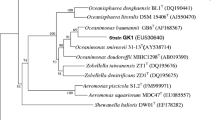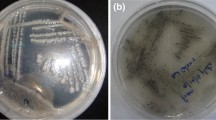Abstract
Polyhydroxybutyrates (PHB) are biodegradable polymers that are produced by various microbes, including Ralstonia, Pseudomonas, and Bacillus species. In this study, a Vibrio proteolyticus strain, which produces a high level of polyhydroxyalkanoate (PHA), was isolated from the Korean marine environment. To determine optimal growth and production conditions, environments with different salinity, carbon sources, and nitrogen sources were evaluated. We found that the use of a medium containing 2% (w/v) fructose, 0.3% (w/v) yeast extract, and 5% (w/v) sodium chloride (NaCl) in M9 minimal medium resulted in high PHA content (54.7%) and biomass (4.94 g/L) over 48 h. Addition of propionate resulted in the production of poly(3-hydroxybutyrate-co-3-hydroxyvalerate) (P(HB-co-HV)) copolymer as propionate acts as a precursor for the HV unit. In these conditions, the bacteria produced poly(3-hydroxybutyrate-co-3-hydroxyvalerate) containing a 15.8% 3HV fraction with 0.3% propionate added as the substrate. To examine the possibility of using unsterilized media with high NaCl content for PHB production, V. proteolyticus was cultured in sterilized and unsterilized conditions. Our results indicated a higher growth, leading to a dominant population in unsterilized conditions and higher PHB production. This study showed the conditions for halophilic PHA producers to be later implemented at a larger scale.







Similar content being viewed by others
References
Huijberts GN, Eggink G, de Waard P, Huisman GW, Witholt B (1992) Pseudomonas putida KT2442 cultivated on glucose accumulates poly(3-hydroxyalkanoates) consisting of saturated and unsaturated monomers. Appl Environ Microbiol 58(2):536–544
McCool GJ, Cannon MC (1999) Polyhydroxyalkanoate inclusion body-associated proteins and coding region in Bacillus megaterium. J Bacteriol 181(2):585–592
Jeon JM, Brigham CJ, Kim YH, Kim HJ, Yi DH, Kim H, Rha C, Sinskey AJ, Yang YH (2014) Biosynthesis of poly(3-hydroxybutyrate-co-3-hydroxyhexanoate) (P(HB-co-HHx)) from butyrate using engineered Ralstonia eutropha. Appl Microbiol Biotechnol 98(12):5461–5469. https://doi.org/10.1007/s00253-014-5617-7
Khanna S, Srivastava AK (2005) Recent advances in microbial polyhydroxyalkanoates. Process Biochem 40(2):607–619. https://doi.org/10.1016/j.procbio.2004.01.053
Shah AA, Hasan F, Hameed A, Ahmed S (2008) Biological degradation of plastics: a comprehensive review. Biotechnol Adv 26(3):246–265. https://doi.org/10.1016/j.biotechadv.2007.12.005
Lu JN, Tappel RC, Nomura CT (2009) Mini-Review: Biosynthesis of Poly(hydroxyalkanoates). Polym Rev 49(3):226–248. https://doi.org/10.1080/15583720903048243
Johnson J, Sudheer PDVN, Yang Y-H, Kim Y-G, Choi K-Y (2017) Hydrolytic activities of hydrolase enzymes from halophilic microorganisms. Biotechnol Bioprocess Eng 22(4):450–461. https://doi.org/10.1007/s12257-017-0113-4
Bhatia SK, Kim J, Song H-S, Kim HJ, Jeon J-M, Sathiyanarayanan G, Yoon J-J, Park K, Kim Y-G, Yang Y-H (2017) Microbial biodiesel production from oil palm biomass hydrolysate using marine Rhodococcus sp. YHY01. Bioresour Technol 233:99–109. https://doi.org/10.1016/j.biortech.2017.02.061
Fenical W, Jensen PR (2006) Developing a new resource for drug discovery: marine actinomycete bacteria. Nat Chem Biol 2:666. https://doi.org/10.1038/nchembio841
Annamalai N, Thavasi R, Vijayalakshmi S, Balasubramanian T (2011) A novel thermostable and halostable carboxymethylcellulase from marine bacterium Bacillus licheniformis. World J Microbiol Biotechnol AU01(9):2111–2115 27
Wang X, Zhao Y, Tan H, Chi N, Zhang Q, Du Y, Yin H (2014) Characterisation of a chitinase from Pseudoalteromonas sp. DL-6, a marine psychrophilic bacterium. Int J Biol Macromol 70:455–462. https://doi.org/10.1016/j.ijbiomac.2014.07.033
Gunny AAN, Arbain D, Edwin Gumba R, Jong BC, Jamal P (2014) Potential halophilic cellulases for in situ enzymatic saccharification of ionic liquids pretreated lignocelluloses. Bioresour Technol 155:177–181. https://doi.org/10.1016/j.biortech.2013.12.101
Tan D, Xue Y-S, Aibaidula G, Chen G-Q (2011) Unsterile and continuous production of polyhydroxybutyrate by Halomonas TD01. Bioresour Technol 102(17):8130–8136. https://doi.org/10.1016/j.biortech.2011.05.068
Jeanmougin F, Thompson JD, Gouy M, Higgins DG, Gibson TJ (1998) Multiple sequence alignment with Clustal X. Trends Biochem Sci 23(10):403–405
Page RDM (1996) Tree view: an application to display phylogenetic trees on personal computers. Bioinformatics 12(4):357–358. https://doi.org/10.1093/bioinformatics/12.4.357
Braunegg G, Sonnleitner B, Lafferty RM (1978) Rapid gas-chromatographic method for determination of poly-beta-hydroxybutyric acid in microbial biomass. Eur J Appl Microbiol 6(1):29–37
Bossio DA, Scow KM, Gunapala N, Graham KJ (1998) Determinants of soil microbial communities: effects of agricultural management, season, and soil type on phospholipid fatty acid profiles. Microb Ecol 36(1):1–12. https://doi.org/10.1007/s002489900087
Singh M, Patel SK, Kalia VC (2009) Bacillus subtilis as potential producer for polyhydroxyalkanoates. Microb Cell Fact 8(1):38
Sun W, Cao J-G, Teng K, Meighen EA (1994) Biosynthesis of poly-3-hydroxybutyrate in the luminescent bacterium, Vibrio harveyi, and regulation by the lux autoinducer, N-(3-hydroxybutanoyl) homoserine lactone. J Biol Chem 269(32):20785–20790
Mohandas S, Balan L, Lekshmi N, Cubelio S, Philip R, Bright Singh I (2017) Production and characterization of Polyhydroxybutyrate from Vibrio Harveyi MCCB 284 utilizing glycerol as carbon source. J Appl Microbiol 122(3):698–707
Yang Y-H, Brigham CJ, Budde CF, Boccazzi P, Willis LB, Hassan MA, Yusof ZAM, Rha C, Sinskey AJ (2010) Optimization of growth media components for polyhydroxyalkanoate (PHA) production from organic acids by Ralstonia eutropha. Appl Microbiol Biotechnol 87(6):2037–2045
Sudesh K, Abe H, Doi Y (2000) Synthesis, structure and properties of polyhydroxyalkanoates: biological polyesters. Prog Polym Sci 25(10):1503–1555. https://doi.org/10.1016/S0079-6700(00)00035-6
Valappil SP, Misra SK, Boccaccini AR, Keshavarz T, Bucke C, Roy I (2007) Large-scale production and efficient recovery of PHB with desirable material properties, from the newly characterised Bacillus cereus SPV. J Biotechnol 132(3):251–258. https://doi.org/10.1016/j.jbiotec.2007.03.013
Takahashi R, Castilho N, Silva M, Miotto M, Lima A (2017) Prospecting for marine bacteria for polyhydroxyalkanoate production on low-cost substrates. Bioengineering 4(3):60
Drenovsky RE, Elliott GN, Graham KJ, Scow KM (2004) Comparison of phospholipid fatty acid (PLFA) and total soil fatty acid methyl esters (TSFAME) for characterizing soil microbial communities. Soil Biol Biochem 36(11):1793–1800. https://doi.org/10.1016/j.soilbio.2004.05.002
Acknowledgements
This study was supported by the National Research Foundation of Korea (NRF) (NRF-2015M1A5A1037196, 2016R1D1A1B03932163, NRF-2017R1D1A1B03033594) and Polar Academic Program (PAP, PE18900). This paper was also supported by Konkuk University Researcher Fund in 2017. Consulting service from the Microbial Carbohydrate Resource Bank (MCRB, Seoul, Korea) was kindly appreciated.
Author information
Authors and Affiliations
Corresponding author
Additional information
Publisher’s Note
Springer Nature remains neutral with regard to jurisdictional claims in published maps and institutional affiliations.
Electronic supplementary material
Below is the link to the electronic supplementary material.
Rights and permissions
About this article
Cite this article
Hong, JW., Song, HS., Moon, YM. et al. Polyhydroxybutyrate production in halophilic marine bacteria Vibrio proteolyticus isolated from the Korean peninsula. Bioprocess Biosyst Eng 42, 603–610 (2019). https://doi.org/10.1007/s00449-018-02066-6
Received:
Accepted:
Published:
Issue Date:
DOI: https://doi.org/10.1007/s00449-018-02066-6




